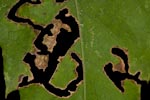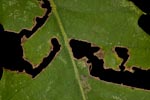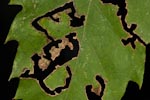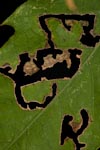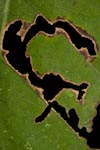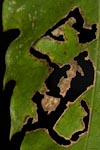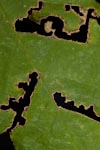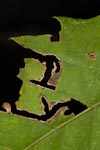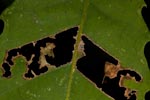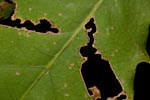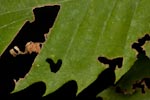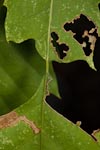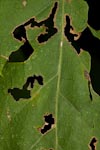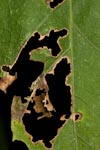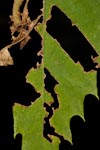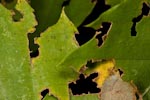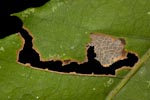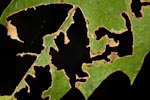
(Additional content at flickr Photostream and YouTube Channel)
If you have botany questions or comments please email BobK . Thanks!
Biennial Gaura acts like Evening Primrose
September 29, 2010
Waldo (wherever that is), Marion County, Ohio
September 29, 2010
Waldo (wherever that is), Marion County, Ohio
Even though it's in the
evening-primrose family (Onagraceae), which does indeed include some
strictly night-blooming plants, this biennial gaura, Gaura biennis, is
pollinated principally by day-flying bees. The fowers apparently are
atttractive at night as well, and it would have been hard not to notice
this specimen
looking quite pretty well after nightfall.
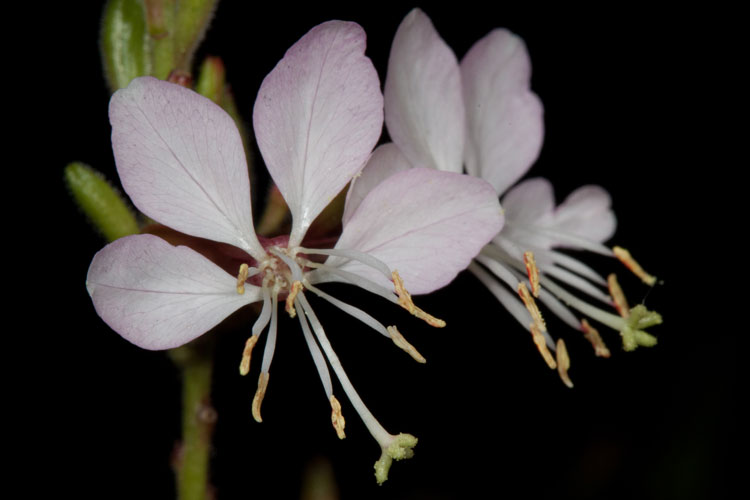
Gaura biennis during the evening of September 29, 2010. Marion County, Ohio.

Gaura biennis during the evening of September 29, 2010. Marion County, Ohio.
Gaura
is a fairly common
late-summer/early autumn wildflower with
spectacular, albeit smallish, flowers. The plant has
an rather thin and wiry appearance, causing it to be easily
overlooked. This gaura is a native plant found in most of eastern North
America, occupying disturbed areas, dry meadows and prairies. It
prominently displays several
features of
the Onagraceae. Note in the photo above the 4 petals, 8
stamens, and the very long
style ending in a cross-shaped set of 4 wide-spreading stigma lobes.
Other pertinent aspects of the evening-primrose family flower structure are better seen in this image from last year, taken at the OSU-Marion Prairie, wherein we see clearly the "inferior" placement of the ovary, i.e., the ovary is situated beneath all the other flower parts. Like all flowers with an inferior ovary, the bases of the sepals (of which here there are only 2!) and petals (of which here there are 4) are fused into a special tube called the "hypanthium" that is itself fused to, and then extends above, the ovary. In Gaura and other members of its family the hypanthium is so very long that it could be mistaken for a flower stalk (pedicel). The Gaura gflowers are actually sessile, i.e., attached directly to the stem, without a stalk.
American chestnut, Castanea dentata (Fagaceae), was a dominant component of Appalachian forests until it was all but eliminated by an introduced fungus disease around the turn of the last century. The species persists as stump sprouts, which succumb to the fungus as soon as they reach pole size.
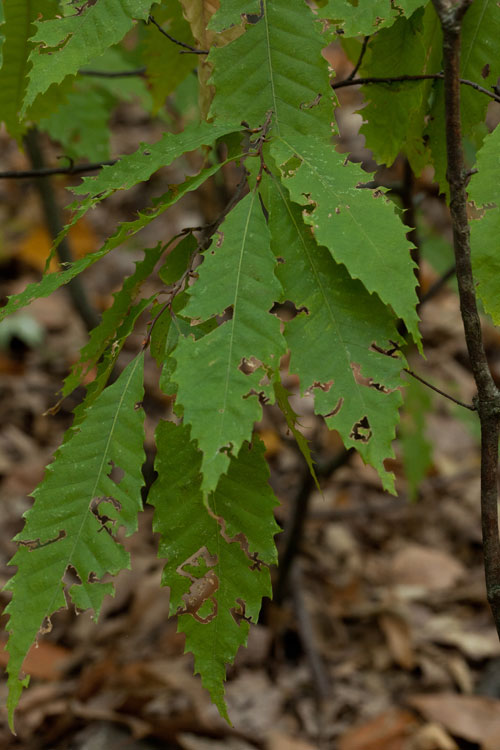
American chestnut persists as stump sprouts.
September 19, 2010. Berks County, PA.
Each year we try to go to Hawk Mountain Sanctuary to see the hawks migrate along the Kittatinny Ridge, and have a little "family reunion." It's great fun, and very relaxing. An additonal treat is camping at the fairly rustic "Blue Rocks Family Campground," where, among other things, there's a good number of American Chestnut sprouts.
It was intriguing to observe the extent of herbivory on the leaves of chestnut during the evening of September 18-19, 2010. Although there is no way to tell what types of insects feasted so avidly here, because insects in general are the main food for many birds and other wildlife, this observation is a testament to the former ecological importance of chestnut in these forests.
MUNCHED CHESTNUT LEAVES PHOTO GALLERY
(This is the abridged version: The full gallery can be seen HERE)
-----Click to Enlarge-----
All summer long, mingled with the milkweeds at Killdeer, there have been these supple little herbs with oppositely arranged pinnately compound leaves gradually tranforming themselves into supple big herbs with oppositely arranged pinnately compound leaves. Now they are flowering, and the place is a sea of yellow. This yellow beauty is Ozark tickseed-sunflower, Bidens polylepis (Asteraceae, the sunflower family), one of our few non-native plants indigenous not to faraway Europe or Asia, but closer to home, i.e., elsewhere in North America. The species is native to states immediately west of Ohio, and was in fact considered native by Cooperrider, Cusick and Kartesz (2000) in their Seventh catalog of the vascular plants of Ohio. However, in 2004, after noting that there was only one pre-1950 specimen of this now fairly common plant in the OSU Herbarium (OS), Andreas, Mack and McCormack revised the plant's status to "alien" in their Floristic Quality Assessment Index (FQAI) for Vascular Plants and Mosses for the State of Ohio. However, the distinction may have now be moot, as more recent treatments of the genus lump B. polylepis together with B. aristosa (bearded beggarticks), a known Ohio native.
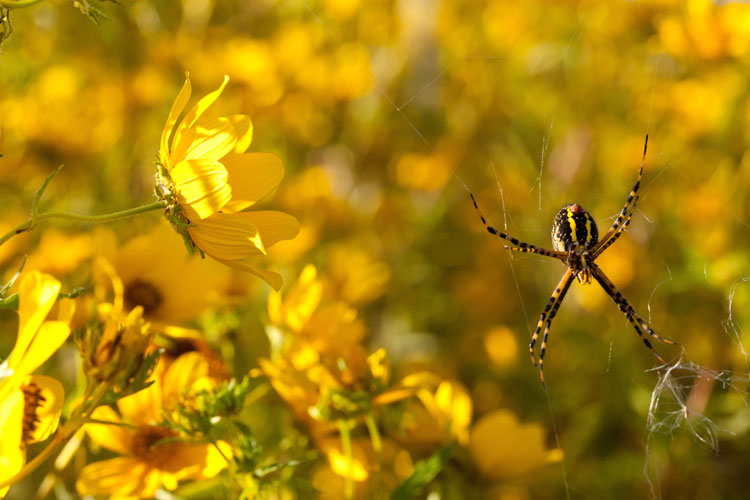
Bidens and Argiope at Killdeer. September 8, 2010.
Other pertinent aspects of the evening-primrose family flower structure are better seen in this image from last year, taken at the OSU-Marion Prairie, wherein we see clearly the "inferior" placement of the ovary, i.e., the ovary is situated beneath all the other flower parts. Like all flowers with an inferior ovary, the bases of the sepals (of which here there are only 2!) and petals (of which here there are 4) are fused into a special tube called the "hypanthium" that is itself fused to, and then extends above, the ovary. In Gaura and other members of its family the hypanthium is so very long that it could be mistaken for a flower stalk (pedicel). The Gaura gflowers are actually sessile, i.e., attached directly to the stem, without a stalk.
MOUSEOVER the
image to
see
interpretive LABELS
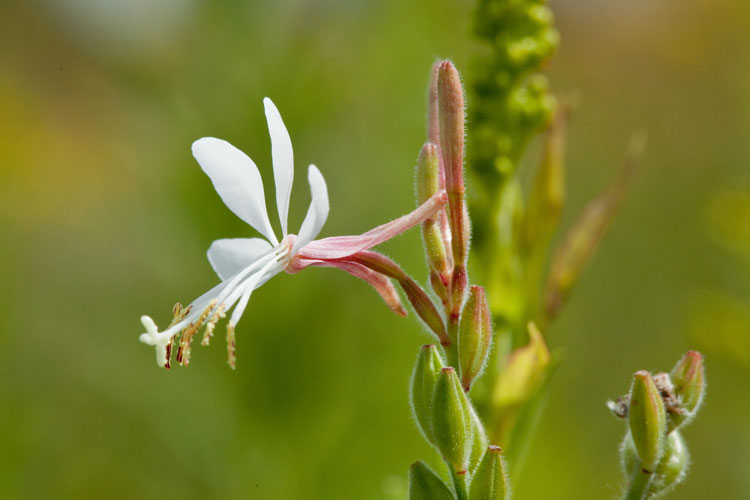
September 29, 2010. Waldo, Marion County, Ohio.
Here's another moth, this one resting, on a gaura blossom. Note the plumose antennae, a useful way to distinguish moths from butterflies, which have filiform antennae.
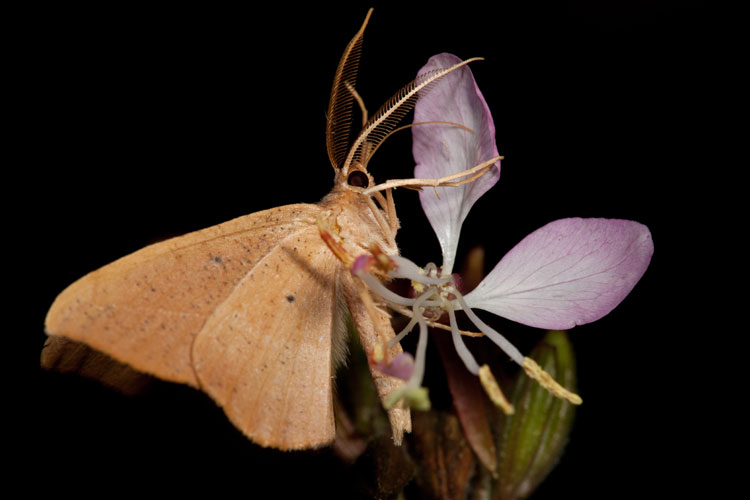
Moths have plumose antennae.
September 29, 2010. Marion County, Ohio.

Gaura
flowers are sessile, with an inferior ovary and a very long hypanthium.
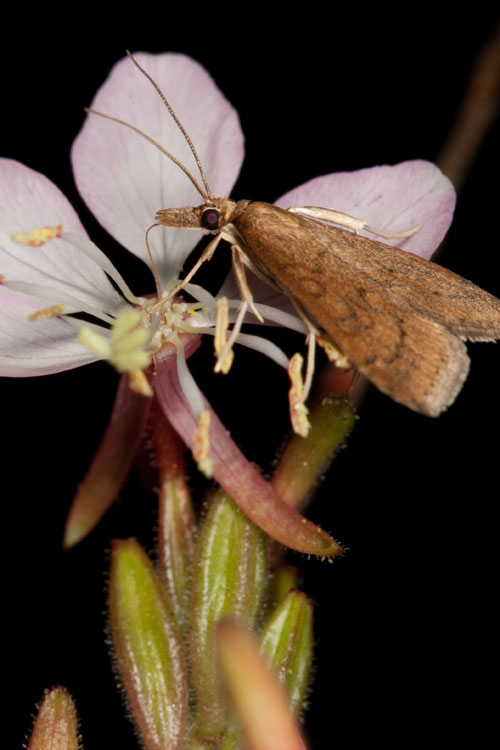
A moth, possible Zanthcognantha,
forages on gaura. Tonight
the gaura flowers are being visited by moths, and it is reasonable to
assume they may act as pollinators too. This moth appears to be a type
of looper in the genus Zanclognantha,
the larvae of which feed, interestingly, on dead leaves.

September 29, 2010. Waldo, Marion County, Ohio.
Here's another moth, this one resting, on a gaura blossom. Note the plumose antennae, a useful way to distinguish moths from butterflies, which have filiform antennae.

Moths have plumose antennae.
September 29, 2010. Marion County, Ohio.
Bugs on Trees, Bugs in
the Water, and Plants
Caesar Creek Bio-Blitz
Warren County, Ohio
September 24-25, 2010
Caesar Creek Bio-Blitz
Warren County, Ohio
September 24-25, 2010
This year, like
last year and
next year, the U.S. Army Corps of Engineers celebrates National Public
lands Day by holding a Bioblitz at Caesar Creek in southeastern Ohio's
Warren County. It's a great educational event. Specialists in various
taxa come to identify as many species as they can during a 24-hour
period from 4:00 p.m. Friday until 4:00 p.m. Saturday. I went there
with two bright young college students, one of whom has 23 chromosomes
with genes that are nearly exact copies of mine (or so I am told), and
we all looked
at bugs and plants. We got there late (this is us we're talking about,
and there was no mutation of the lateness gene from my generation to
hers, that's for sure), so our first bio-activity was looking for
insects at night at the campground.
One of the night-time bugs is this as-yet unidentified owlet moth, or "dart," a member of the large family of so-called "cutworm moths," the Noctuidae. I've tried picture-matching this with as many memberes of the genera Feltia and Euoxa (the closest-looking ones) on various buggy web sites, but none seem quite right.
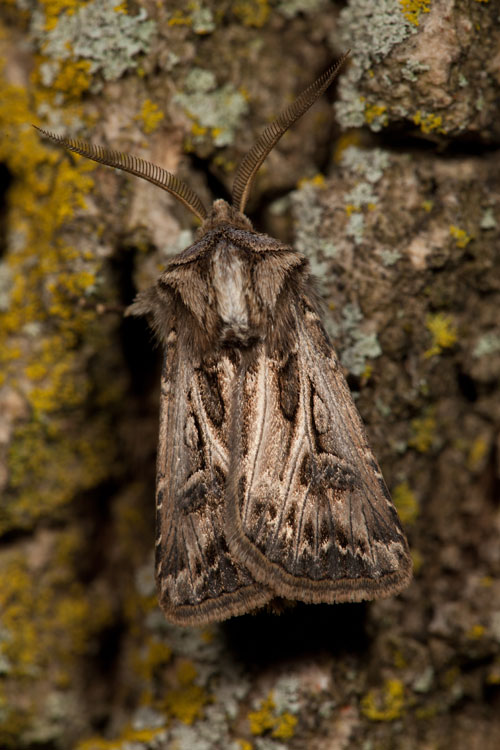
Unidentified cutworm moth resting on a tree at night.
Caesar Creek State Park, Warren County, Ohio. September 25, 2010.
One of the night-time bugs is this as-yet unidentified owlet moth, or "dart," a member of the large family of so-called "cutworm moths," the Noctuidae. I've tried picture-matching this with as many memberes of the genera Feltia and Euoxa (the closest-looking ones) on various buggy web sites, but none seem quite right.

Unidentified cutworm moth resting on a tree at night.
Caesar Creek State Park, Warren County, Ohio. September 25, 2010.
Oooh this is creepy. Aren't
we supposed to be out in the wildnerness? What's a freakin' cockroach
doing here? Oh, wait...yes it's a roach, but it's kind of a nice one.
This is the Pennsylvania wood cockroach, Parcoblatta pennsylvanica,
a species that lives mainly under bark and in hollow trees. It only
comes indoors occassionally, usually hitchhking on firewood. This is a
nymph (immature), a good example of an insect with gradual
metamorphosis, wherein immatures resemble wingless adults, they just
get bigger and bigger with each successive molt until finally achieving
the winged, sexually mature stage, without any intervening cocoon-like
pupal stage.
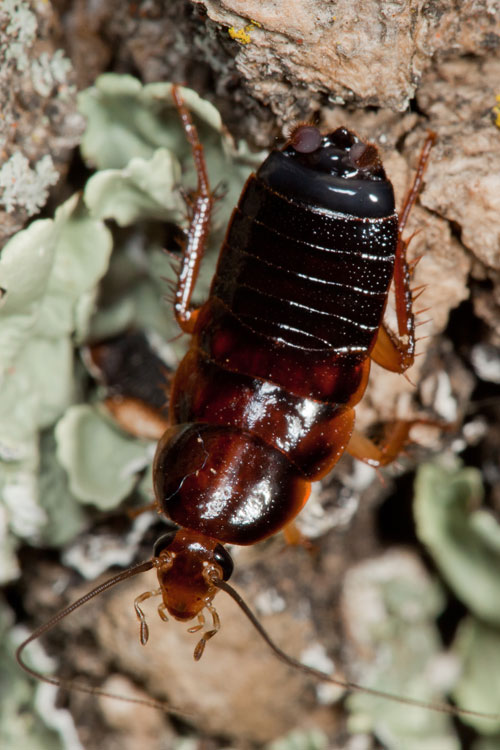
Pennsylvania wood cockroach.
September 25, 2010. Warren County, Ohio.
The next day we explored the creek, and the environs along the creek. It was a treat to see Ohio's largest species of crane fly, Tipula abdominalis. Flies have the complete egg-larvea-pupa-adult metamorphosis type. The larvae of this species are aquatic, common inhabitants of streams in wooded areas, where they feed on decomposing leaves. They are sometimes sought as bait for fishing.
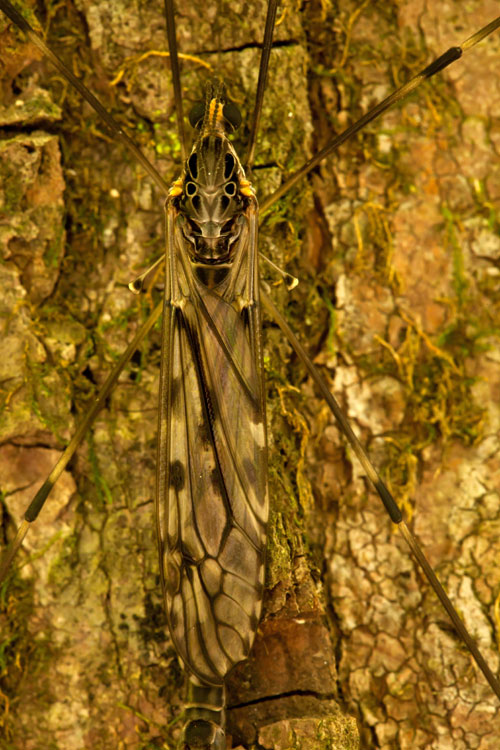
Tipula abdominalis resting on tree, dorsal view.
September 25, 2010. Warren County, Ohio.

Pennsylvania wood cockroach.
September 25, 2010. Warren County, Ohio.
The next day we explored the creek, and the environs along the creek. It was a treat to see Ohio's largest species of crane fly, Tipula abdominalis. Flies have the complete egg-larvea-pupa-adult metamorphosis type. The larvae of this species are aquatic, common inhabitants of streams in wooded areas, where they feed on decomposing leaves. They are sometimes sought as bait for fishing.

Tipula abdominalis resting on tree, dorsal view.
September 25, 2010. Warren County, Ohio.
Crane flies are long-legged
slow-flying insects that are often mistaken for something that doesn't
exist: huge mosquitoes. Here's a side view.
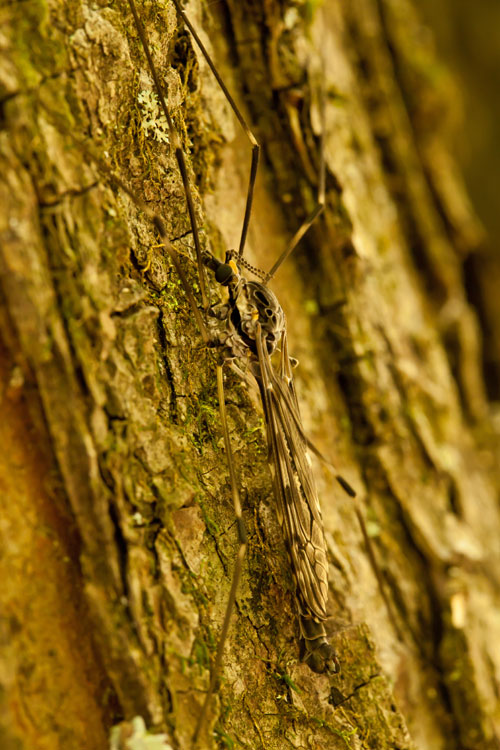
Tipula abdominalis resting on tree, dorsal view.
September 25, 2010. Warren County, Ohio.

Tipula abdominalis resting on tree, dorsal view.
September 25, 2010. Warren County, Ohio.
Wading
in the creek and
gently flipping rocks, our sharp-eyed aquatic entomologist found a
fairly cryptic immature damselfly. Dragonflies and damselflies
--members of the insect order Odonata --occur as predaceous aquatic
larvae called "naiads," as part of a metamorphosis type called
"incomplete." Incomplete metamorphosis is like gradual metamorphosis in
that there is no pupal stage, but here the immatures are aquatic and
strikingly different than the adults.
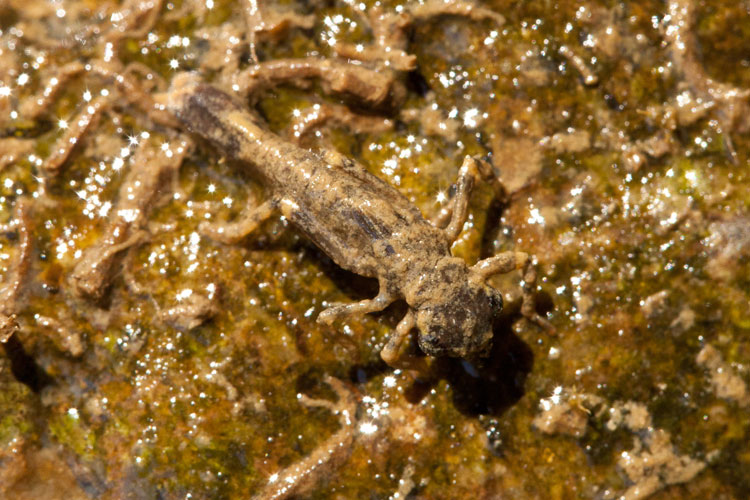
Damselfly naiad in Caesar Creek. September 25, 2010.

Damselfly naiad in Caesar Creek. September 25, 2010.
My job was to look for
mosses. Here's one, a common carpet moss of moist ground that has a
feathery growth form with light green leaves swept to the sides of the
branches. It's Calliergonella
lindbergii in the family Amblystegiaceae, until
quite recently known as Hypnum
lindbergii, and considered a member of a different family
entirely, the Hypnaceae!
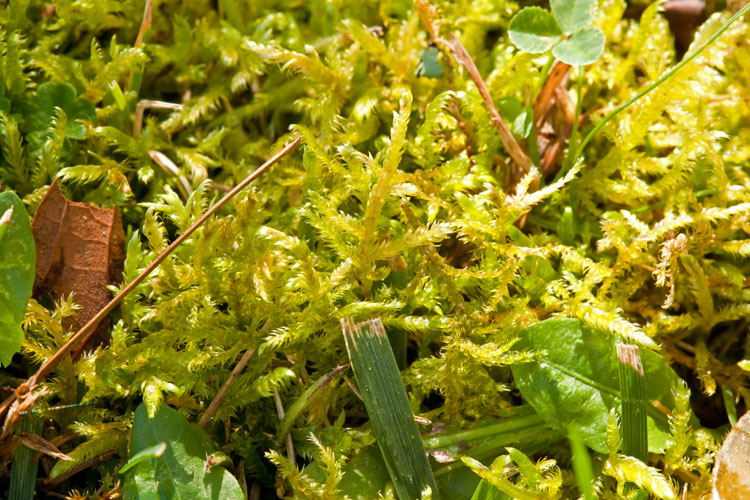
Calliergonella lindbergii is a bright robust feathery carpet moss.
September 25, 2010. Caesar Creek State Park.

Calliergonella lindbergii is a bright robust feathery carpet moss.
September 25, 2010. Caesar Creek State Park.
A highlight of the Caesar
Creek 'blitz is nature walks led by experts, and it was great fun to go
on a fungus hike with the uber-knowledgable
and excellent myco-explainer Nicholas Money of Miami University. The
weather has beed dry as of late, so it was hard to find many fungi, but
find them he did. Here's a pretty distinctive bracket fungus. Sometimes
called "turkey tail" because of its colorful pattern of parallel bands,
this is a extremely common and wide-ranging species, found most often
as a saprophyte on hardwood logs.
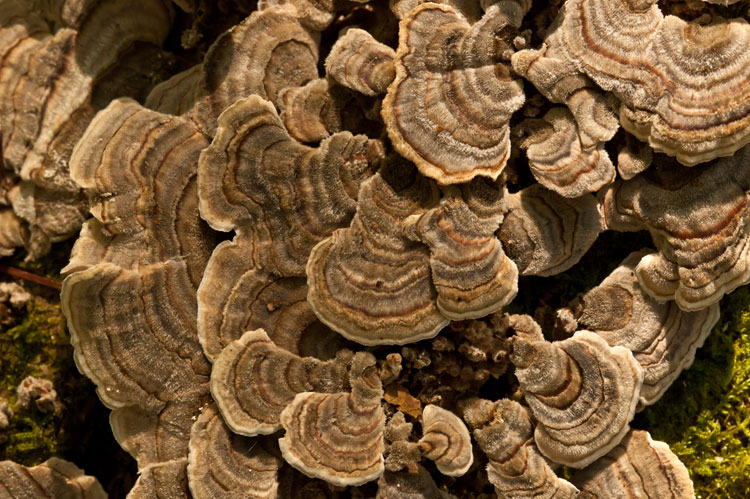
Trametes versicolor is a common saprophyte on hardwood logs.
September 25, 2010. Warren County, Ohio.

Trametes versicolor is a common saprophyte on hardwood logs.
September 25, 2010. Warren County, Ohio.
Turkey tail is a type of club
fungus (basidiomycete) that produces its spores from within
downward-pointing tubes opening on the undersides of the brackets. The
ends of the tubes form distinctive pores, hence these types of fungi
are often called "polypores."
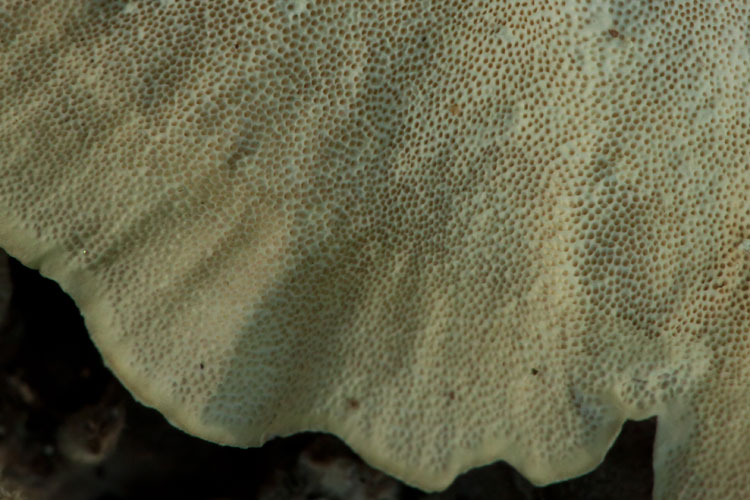
Dr. Money showed us a pore fungus.
September 25, 2010. Caesar Creek. Warren County Ohio.

Dr. Money showed us a pore fungus.
September 25, 2010. Caesar Creek. Warren County Ohio.
This being autumn, the
principal plant family in bloom is the Asteraceae. In this large and
advanced plant family, what look from a distance like individual
blossoms are actually tight head-like clusters, called "capitula" of
small flowers. In asters the flowers are of two types: (1)
strap-shaped outer ones called "ray flowers" that simulate the petals
of larger sinle flowers, and (2) radially symmetric "disk" flowers in
the center of each capitulum. This woodland aster has light blue rays
and yellow disk flowers. It's Short's aster, Symphyotrichum shortii, no longer
called "Aster" shortii
because it's been determined that the North American members of the
large aster group are distinct from the European ones, and now belong
to this crazy new polysyllabic genus. Short's "aster" is
distingished by its leaves: hairless, heart-shaped at the base,
with an non-winged petiole (leaf-stalk).
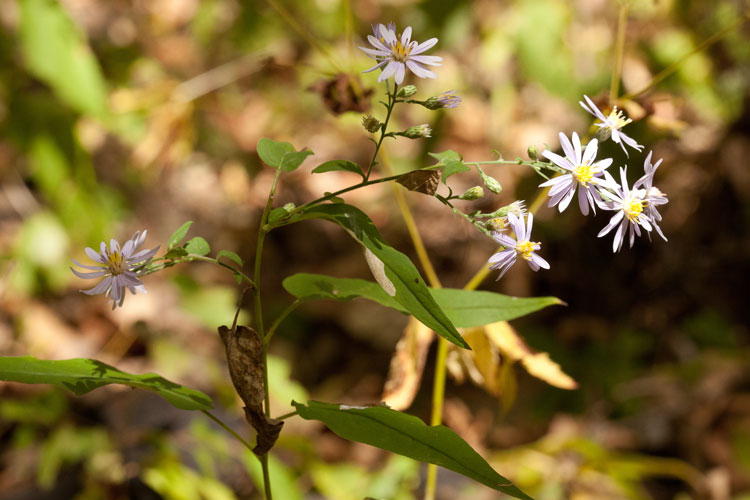
Short's "aster" has long-stalked, non-winged leaves with heart-shaped bases.
September 25, 2010. Warren County, Ohio.

Short's "aster" has long-stalked, non-winged leaves with heart-shaped bases.
September 25, 2010. Warren County, Ohio.
Closely related to Symphyotrichum, the genus Solidago (goldenrods)
mostly includes plants with quite small all-yellow capitula that are
themselves packed closely together into some type of secondary
inflorescence. Here's a lovely woodland species, "zigzag goldenrod," Solidago flexicaulis. Look for
egg-shaped leaves, zigzag stem, and capitula in small clusters just
above the leaves.
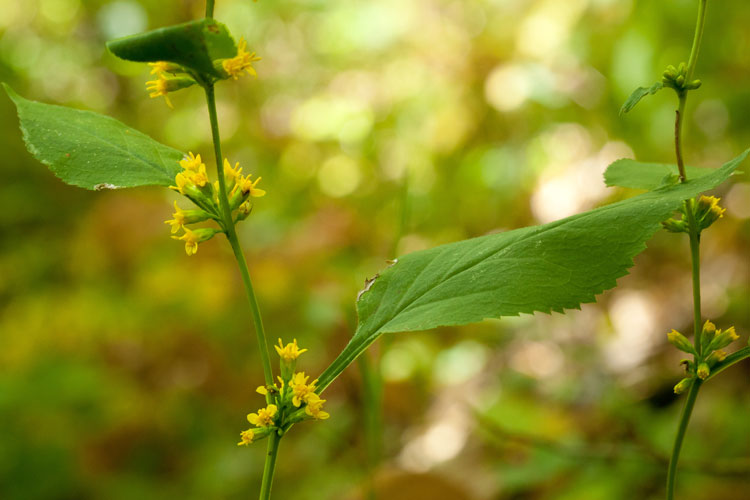
Rod, golden, zag, zig. September 25, 2010. Warren
County, Ohio. 
Tall white lettuce, Prenanthes altissima,
is a woodland species that is a member of the Asteracae tribe
Cichoreae, characterized by having flowers that are only of the
strap-shaped variety (disk flowers are lacking). Also, there are only a
few flowers in each
capitulum, making the whole thing look markedly non-Asteraceae-like.
The Prenanthes capitulum
demonstrates quite well the peculiar pollen
presentation mechanism found in the Asteraceae, wherein each flower's
five
anthers are fused into a tube. The anthers split open (dehisce)
introrsely
(inwardly), and the pollen is picked up on the non-receptive back
surfaces of the style branches as they extend through the anther-tube.
Thus the pollen, produced by the stamens, is actually presented by the
styles.
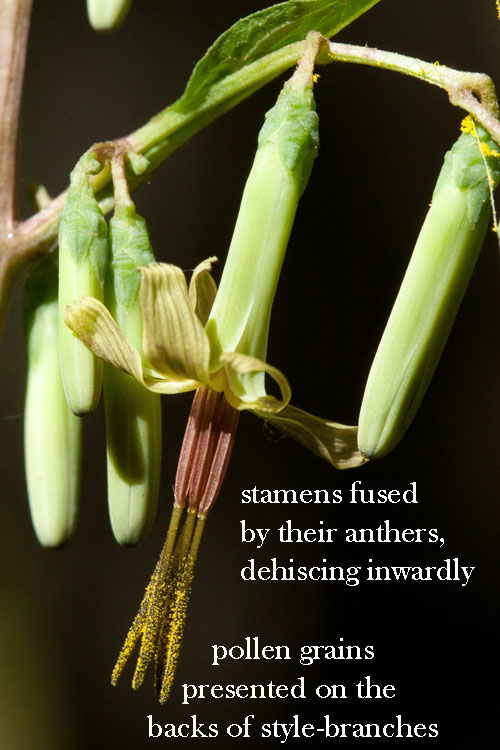
Tall white lettuce capitulum displays peculiar Asteraceae pollen-preentation system.
September 25, 2010. Caesar Creek. Warren County, Ohio.

Tall white lettuce capitulum displays peculiar Asteraceae pollen-preentation system.
September 25, 2010. Caesar Creek. Warren County, Ohio.
Each year the familette goes
on vacay to pay rapt attention to hawks migrating along the Kittatinny
Ridge of the Appalachian Mountains at the wonderful Hawk Mountain
Sanctuary in Berks County, PA.


View from North
Lookout
This vacation
tradition started about 10 years, but it was inspired by a trip
taken much earlier while I was an undergrad at The State University of
New York College of Environmental Science and Forestry ("SUNY- ESF).
Several of us nature-loving "Stumpies" (as ESF students are called)
took a
weekend field trip sometime in the fall of 1975, one of whom snapped a
pic of me
and great friend and then house-mate Diane perhaps looking at some bird
attacking the fake owl on a post at the North Lookout. Now, a great
many years later, still great friend (but no longer house-mate) Diane
joined us at the mountain, where we relocated the precise rock we were
perched on (these are very precise rocks), and re-created the picture.
That was fun!


Bob and Diane, then and
now.
The hike up to the North
Lookout afforded an opportunity to stop and look at some marvelous
saxicolous lichens.
Famously, most lichens are informally assigned to one of three growth form groups: crustose (crust-like); foliose (leafy) and; fruticose (shrubby). This is "rock greenshield lichen," Flavoparmelia baltimoriensis. This is a robust foliose lichen, distinctive by virtue of its being yellow-green, as opposed to gray-green or some other color, and its occurence on rocks. (It's like a saxicolous verison of F. caperata, an uber common bark-dwelling lichen.)
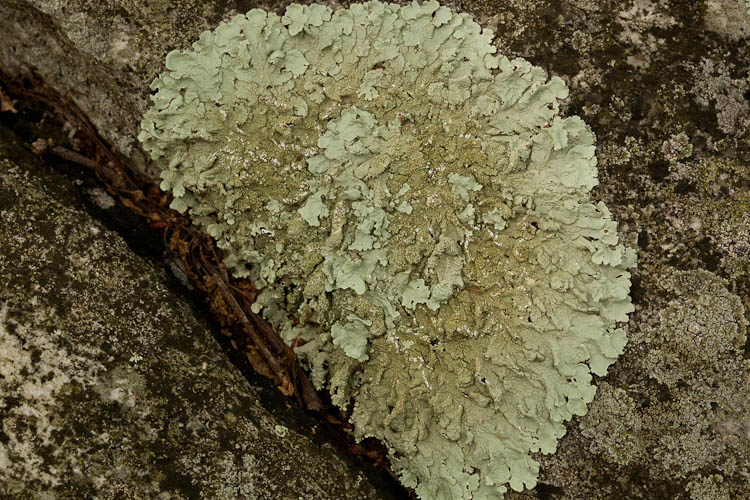
Rock greenshield is a yellow-green foliose lichen that occurs on rock.
Famously, most lichens are informally assigned to one of three growth form groups: crustose (crust-like); foliose (leafy) and; fruticose (shrubby). This is "rock greenshield lichen," Flavoparmelia baltimoriensis. This is a robust foliose lichen, distinctive by virtue of its being yellow-green, as opposed to gray-green or some other color, and its occurence on rocks. (It's like a saxicolous verison of F. caperata, an uber common bark-dwelling lichen.)

Rock greenshield is a yellow-green foliose lichen that occurs on rock.
A
few other lichens on these rocks don't fall neatly into any one of the
three (crustose, foliose, fruticose) categories. "Umbilicate" lichens,
so called because of a similarity to a navel (an "innie," I presume),
are
roughly circular in outline and attached to the substrate only at the
center. The common "rock tripe," Umbilicaria mammulata, is especially conspicuous here.
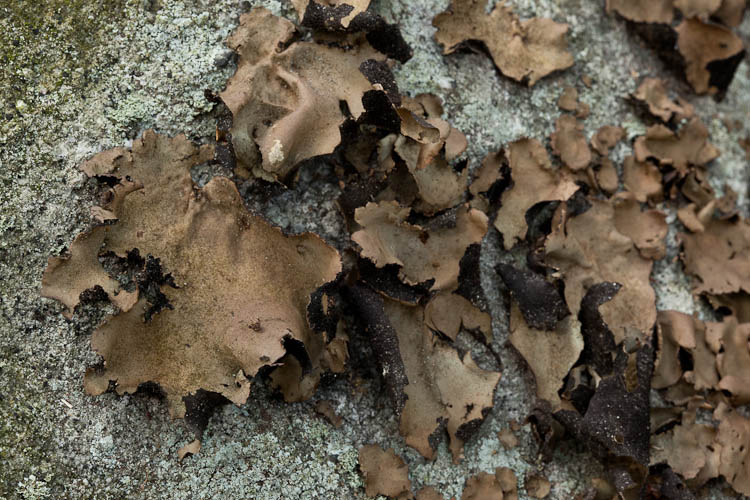
Rock tripe is a distinctive umbillicate lichen.

Rock tripe is a distinctive umbillicate lichen.
Another umbillicate lichen is
"toadskin lichen," Lasallia papulosa.
It's light brown, and has a warty upper surface.
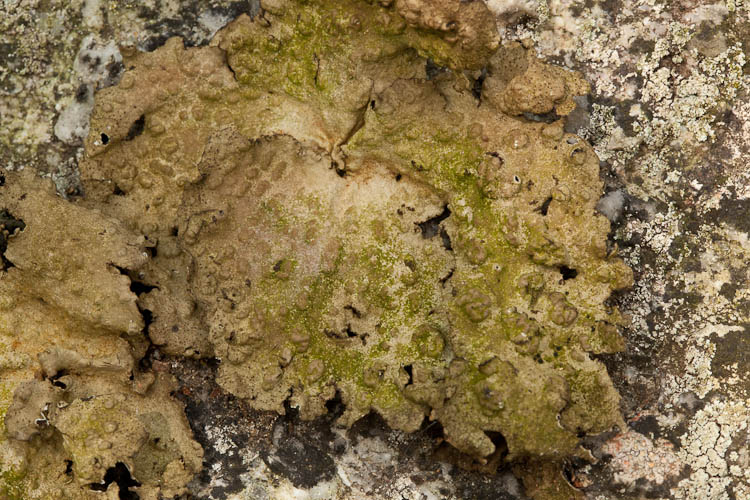
Toadskin lichen is warty.

Toadskin lichen is warty.
An imprecisely defined
intermediate between the crustose and foliose lichen growth form is the
"squamulose" type. These guys are tightly adherent to the substrate
(like crustose ones), but the they have a tendency to be lobulate at
their margins (like foliose ones). This is, I believe, golden moonglow
lichen, Dimelaena oreina.
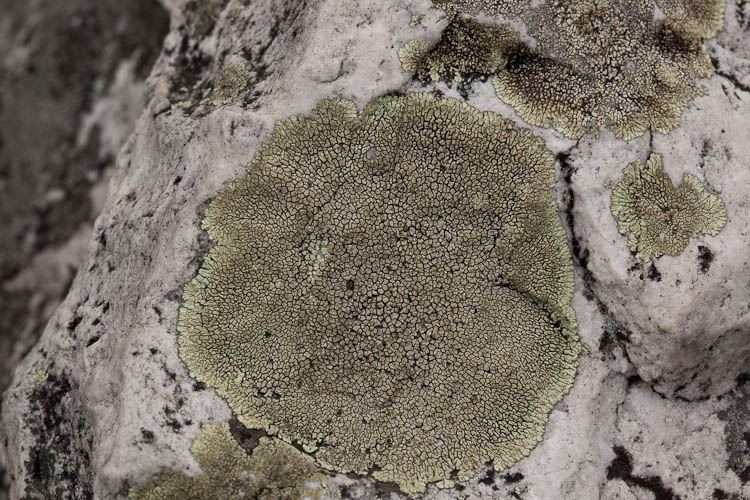
Golden moonglow is a squamulose lichen.

Golden moonglow is a squamulose lichen.
A very cool thing happened
today! A local ant species decided it was time
to mate. Ants are social insects that spend most of the time based in
underground colonies consisting of a single reproductive female --the
queen --and a great number of wingless sterile female workers. Every
few years, winged reproductives stream forth from the ground,
pushed out by the wingless workers. The emergence is synchronized so
that all of the colonies of a particular species in an area form great
cloud-like swarms of winged ants, most of which are males, but a
fraction of them are the future queens that will found new
colonies.
Here are some pics of the emergence. The little red ones without wings are the workers egging the others on. (That is a bad choice of words, since they are sterile and have no eggs.) Among the winged ones, the larger ants are, I believe, the females.
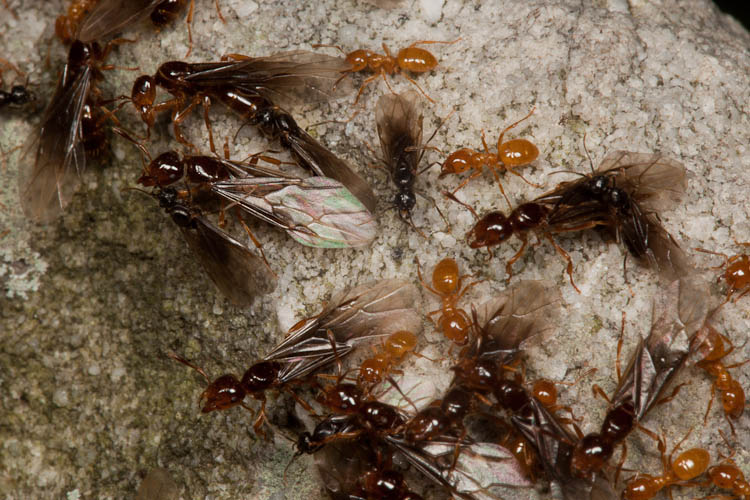
Ant emergence at Hawk Mountain. September 19, 2011.
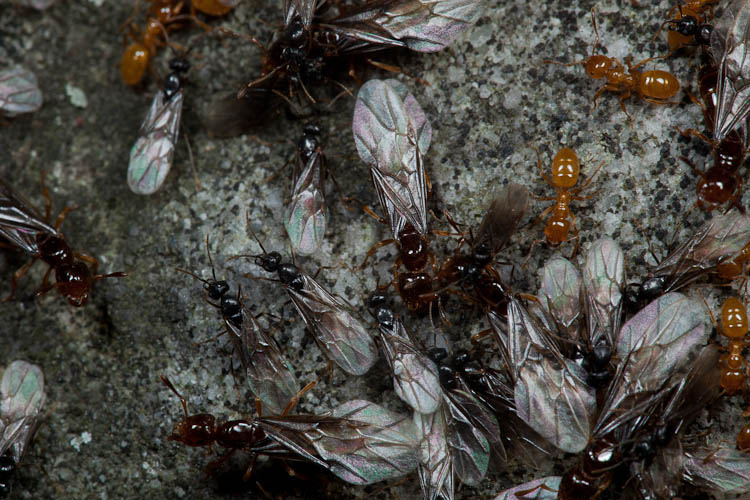
Ant emergence at Hawk Mountain. September 19, 2010.
Ant emergence at Hawk Mountain. September 19, 2010.
(The audio features another highly social species.)
Here are some pics of the emergence. The little red ones without wings are the workers egging the others on. (That is a bad choice of words, since they are sterile and have no eggs.) Among the winged ones, the larger ants are, I believe, the females.
Ant emergence at Hawk Mountain. September 19, 2011.
Ant emergence at Hawk Mountain. September 19, 2010.
Ant emergence at Hawk Mountain. September 19, 2010.
(The audio features another highly social species.)
American chestnut, Castanea dentata (Fagaceae), was a dominant component of Appalachian forests until it was all but eliminated by an introduced fungus disease around the turn of the last century. The species persists as stump sprouts, which succumb to the fungus as soon as they reach pole size.

American chestnut persists as stump sprouts.
September 19, 2010. Berks County, PA.
Each year we try to go to Hawk Mountain Sanctuary to see the hawks migrate along the Kittatinny Ridge, and have a little "family reunion." It's great fun, and very relaxing. An additonal treat is camping at the fairly rustic "Blue Rocks Family Campground," where, among other things, there's a good number of American Chestnut sprouts.
It was intriguing to observe the extent of herbivory on the leaves of chestnut during the evening of September 18-19, 2010. Although there is no way to tell what types of insects feasted so avidly here, because insects in general are the main food for many birds and other wildlife, this observation is a testament to the former ecological importance of chestnut in these forests.
MUNCHED CHESTNUT LEAVES PHOTO GALLERY
(This is the abridged version: The full gallery can be seen HERE)
-----Click to Enlarge-----
Color-coordinated
Flowers and Spiders
(Bidens polylepis and Argiope trifasciata)
Killdeer Plains Wildlife Area
Marion County, Ohio. September 8, 2010
(Bidens polylepis and Argiope trifasciata)
Killdeer Plains Wildlife Area
Marion County, Ohio. September 8, 2010
All summer long, mingled with the milkweeds at Killdeer, there have been these supple little herbs with oppositely arranged pinnately compound leaves gradually tranforming themselves into supple big herbs with oppositely arranged pinnately compound leaves. Now they are flowering, and the place is a sea of yellow. This yellow beauty is Ozark tickseed-sunflower, Bidens polylepis (Asteraceae, the sunflower family), one of our few non-native plants indigenous not to faraway Europe or Asia, but closer to home, i.e., elsewhere in North America. The species is native to states immediately west of Ohio, and was in fact considered native by Cooperrider, Cusick and Kartesz (2000) in their Seventh catalog of the vascular plants of Ohio. However, in 2004, after noting that there was only one pre-1950 specimen of this now fairly common plant in the OSU Herbarium (OS), Andreas, Mack and McCormack revised the plant's status to "alien" in their Floristic Quality Assessment Index (FQAI) for Vascular Plants and Mosses for the State of Ohio. However, the distinction may have now be moot, as more recent treatments of the genus lump B. polylepis together with B. aristosa (bearded beggarticks), a known Ohio native.

Bidens and Argiope at Killdeer. September 8, 2010.
The spider is a very widely
distributed type of orb-weaver (family Araneidae), the banded garden
spider, Argiope trifasciata.
This picture shows its distinctively banded dorsal surface.
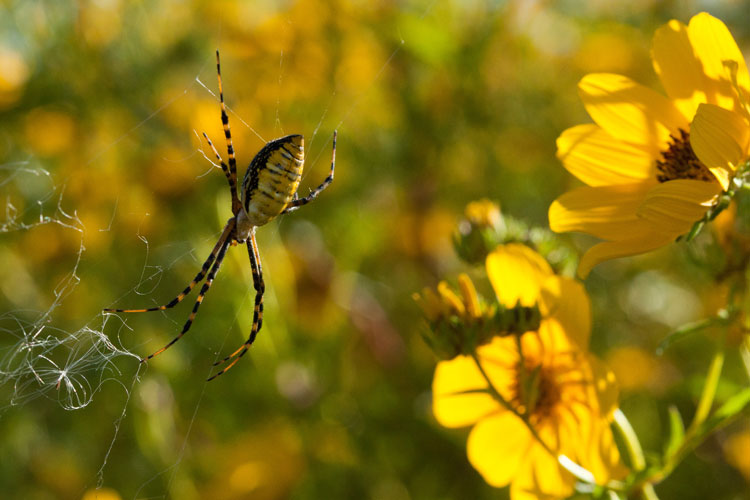
Banded garden spider (female) at Killdeer Plains on September 8, 2010.
As explained by Richard Bradley in his excellent guide "In
Ohio's Backyard: Spiders" (2004, Ohio Biological Survey). male and
female spiders differ not only in their reproductive anatomy, but also
in size and life history. Females are larger than males, and they tend
to stay in one place more than do males, which spend the adult portions
of their lives searching for females. Here at Killdeer, a male seems to
have been successful in his quest, and is now cautiously
approaching her on the web.
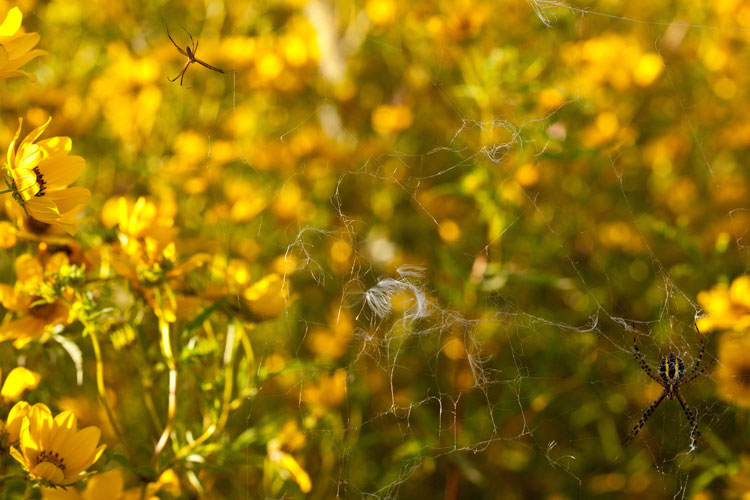
Argiope trifasciata spiders: male (upper left) and female (lower right).


Banded garden spider (female) at Killdeer Plains on September 8, 2010.

Argiope trifasciata spiders: male (upper left) and female (lower right).
...here he's approached a bit
closer.
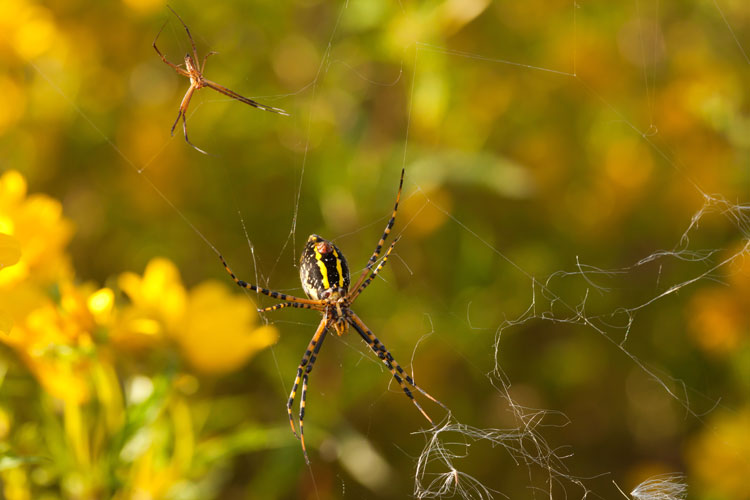
Argiope trifasciata spiders: male (upper left) and female (lower right).

Argiope trifasciata spiders: male (upper left) and female (lower right).
Here's a closer view of
"Charley" (counterpart to "Charlotte").
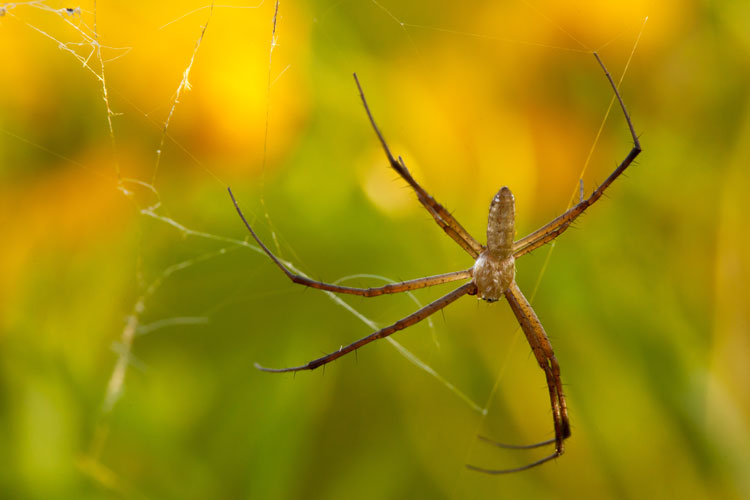
Male banded garden spider. September 8, 2010. Marion County, Ohio.

Male banded garden spider. September 8, 2010. Marion County, Ohio.

